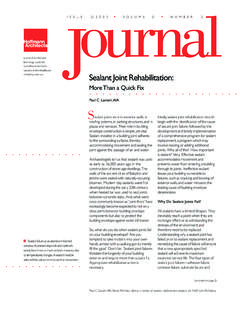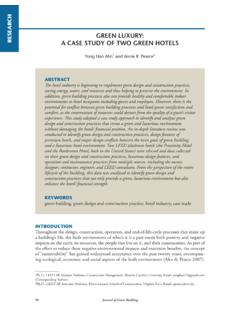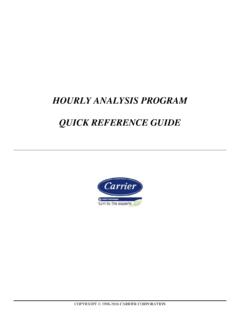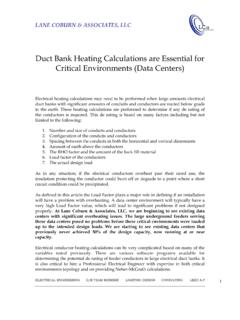Transcription of Balcony and Roof Railings and the Code
1 John P. Graz, AIA, Senior Architect, has extensive experience in building enclosure code compliance, including the design, maintenance, and rehabilitation of railing systems. Rachel C. Palisin, PE, LEED AP BD+C, Project Engineer, provides structural consultation for Railings and other building enclosure of architectural technology published by Hoffmann Architects, Inc., specialists in the rehabilitation of building S S U E 1/2017 VOLUME 34 NUMBER 1 hile the combination of state and local building, fire, and occupa-tional safety codes has the effect of making roofs, balconies, and terraces more secure for those who use them, the tangled web of requirements can wreak havoc with a building owner or facility manager s exterior envelope project. Where existing Railings also known as guards need replacement to meet stringent code requirements, the expense of thousands of linear feet of new Railings can be an unex-pected blow to a project budget.
2 Lacking familiarity with current re-quirements, some owners or man-agers complete a roof or Balcony rehabilitation, only to learn after the fact that they need to tear non-com-pliant Railings out of their new roof or terrace and install new ones. The best strategy is to learn how railing regulations could impact the scope, logistics, and schedule of a building envelope project and its cost. New Railings , depending on complexity and materials, typically cost between $150 and $1,000 per linear foot. A 20-foot-by-20-foot roof terrace, or five small residential balconies, could easily cost $40,000 to replace or install OverviewThe Victorian era saw not only the in-troduction of iron Railings , but also the first standardized, widely-applied build-ing codes. Requirements were enacted for building standards, such as fire resistance, drainage, and fall protection. The use of Railings at roof edges, bal-cony enclosures, and elevated terraces became not just good practice, but a legal is the case with many elements of the building enclosure, roof and Balcony Railings have been subject to changing regulations with successive iterations of the codes.
3 Unless a build-ing owner plans for a change in occu-pancy, such as converting a roof area to a pedestrian terrace, or modifica-tions, such as a roof replacement or Balcony upgrades, existing Railings may be permitted to remain, provided they are not designated hazardous and meet the building codes that were in place at the time of construction. However, such grandfathered railing exemptions are typically granted on a case-by-case basis, and it is best not to assume that Railings may remain unmodified. Researching the code requirements and the interpretation of those requirements in the local ju-risdiction should occur early in project planning, the better to anticipate any railing upgrades or replacements that may be As codes change, owners may find that existing Railings must be updated or P. Graz, AIA and Rachel C. Palisin, PE, LEED AP BD+CBalcony and Roof Railings and the Code: Maintain, Repair, or Replace?Does building have any exterior spaces elevated more than 30 inches above adjacent surfaces, such as balconies or terraces?
4 2 JOURNALDo My Roofs, Balconies, or Terraces Need New or Updated Railings ?Are these spaces regularly accessed by building occupants?Are there any flat or low-slope roofs (4:12 slope or less)?YESNOIs building landmarked or subject to architectural/historic review board?NEED Railings per 2015 International Building Code (IBC) Section 1015** but must be compatible with existing building fabric and/or follow local design Railings may be required per Occupational Safety and Health Administration (OSHA) , and 2015 IBC Railings USUALLY CAN REMAIN but loose, damaged, deficient, or missing Railings must be remedied. Evaluate on case-by-case basis with design professional. ** Railings NOT LIKELY REQUIRED. Fall protection systems might be needed for certain circumstances, such as during construction (OSHA ).Is this a change in occupancy or new construction?Is there mechanical equipment or hatch within 15 feet from edge with 30-inch drop, or skylights?
5 Will modifications be made to the existing roof, Balcony , or terrace?NEED Railings per 2015 IBC Section 1015.**Maintenance access only.* YESNOYESNOYESNOYESNOYESNOYESNONOTES* In New York City, roofs, balconies, or terraces with slope of :12 or less and height of 22 feet or greater require Railings per 2014 NYC Building Code, Section Often, older buildings may comply with the code under which they were constructed.** In NYC, Railings must comply with 2014 NYC Building Code, Section 1013 and 1607. Often, older buildings may comply with earlier codes.** The International Existing Building Code (IEBC) may also be applicable, depending upon building location. 42 4-3/8 MAX. OPENING4 MAX. OPENING50 LBS/ LINEAR FOOTIN ANY DIRECTION200 LBSCONCENTRATEDSTRENGTH REQUIREMENTS:POSTBALUSTERPOSTWALKING SURFACETOP RAIL2015 International Building Code (IBC)42 +3 RAIL200 LBS AT TOP RAILDOWNWARD OROUTWARD150 LBS AT MID RAILDOWNWARD OROUTWARDSTRENGTH REQUIREMENTS:MID RAILPOSTPOSTWALKING SURFACEO ccupational Safety and Health Administration (OSHA), 3 VOLUME 34 NUMBER 1 International Building CodeThe predominant model code that dictates railing assembly height, configuration, and anchorage is the International Code Council International Building Code (IBC), which is in use or adopted in all 50 states and the District of Columbia.
6 The latest version was published in 2015, but many states have yet to adopt the newer code, with some still using ver-sions from as early as 2003. This varia-tion in adoption can mean that regula-tions for Railings can differ between states, with some holding buildings to more rigorous standards than diagram at the top of this page illustrates the dimensional and struc-tural requirements of the 2015 IBC, which demands higher performance than previous iterations. The 2015 IBC mandates that glass used in railing systems generally be laminated tem-pered glass, whereas the 2012 IBC ac-cepted single tempered glass. Beyond the most recent revision, additional changes pile up when looking back just a few code cycles. For example, the 2015 IBC limits openings near the top of the Railings to a maximum diameter of 4-3/8 ; as recently as the 2006 edi-tion, the IBC allowed top rail openings up to 8 diameter. As codes become more demanding, it is easy to see how a building constructed several years or several decades earlier could have Railings which fall well short of meeting current Safety and Health AdministrationWith the passage of the Occupational Safety and Health Act (OSHA) of 1970, fall protection not only for building oc-cupants, but also for workers became protected by code.
7 Even spaces not accessed by the public require fall protection. OSHA provides requirements for fall protection both at construction sites (Occupational Safety and Health Standards Part 1926 M) and for build-ings in use by workers (Part 1910 D). For a graphical depiction of the latter, see the diagram above. Note that updated regulations went into effect January 17, 2017; these include op-tions for fall areas, such as rooftop equip-ment spaces and maintenance ter-races, may be subject to both IBC and OSHA regulations. Often the stipula-tions overlap, but where one is more stringent than the other, it should be followed as a matter of course. International Existing Building CodeAdopted by 39 states and the District of Columbia, the International Existing Building Code (IEBC) is intended to achieve safety standards at existing buildings, with sensitivity to the chal-lenges of achieving full compliance with new construction requirements at older buildings.
8 The IEBC stipulates that building elements cannot be al-tered such that they become less safe than their original condition. Repairs may be performed without changing the entire system. However, where there are no guard Railings or existing Railings need replacement, the IEBC requires that these new elements be constructed in accordance with the current IBC. Some municipalities, such as New York City, do not recognize the IEBC and may subject code requirements for new construction to existing Building CodeEven if the railing design passes muster with IBC and OSHA, there are still Typical Examples of Compliant Railing ConfigurationsILLUSTRATION: STEFFANY MALARIK4 JOURNAL municipal codes to consider. Most of these adopt a version of the IBC, but some jurisdictions, notably New York City, have their own code or jurisdic-tion-specific modifications. The 2014 New York City Building Code (NYC BC) requires that all buildings greater than 22 feet tall with low-slope roofs and terraces have a 42-inch-tall parapet, railing, or fence.
9 On the surface, this seems to line up with IBC and OSHA regulations, but there is one crucial difference: the NYC BC does not limit this require-ment to accessible roof areas. This means that even roofs and ter-races with no entry point from the building interior must still have a safety railing. In an emergency, fire fighters who need to climb onto the roof via ladder or lift bucket risk falling from an unprotected roof edge, especially with smoke reducing visibility. To safeguard first responders, New York enacted this modifications may be enacted at the State or County level as well. For example, North Carolina adopted a provision that requires a curb or toe rail at the base of all Railings to prevent small objects (2 diameter) from falling to adjacent the design team is familiar with code requirements at all applicable jurisdictional levels, such local regula-tions could go unnoticed, leading to violations and potential safety RailingsDepending on the jurisdiction, his-toric and landmark structures may be subject to additional regulations regarding the railing design, beyond those imposed by general building codes.
10 Landmarks review boards and historic preservation offices typically refer to the Secretary of the Interior s Standards for the Treatment of Historic Properties from the National Park Service (NPS). Tax credits for qualifying rehabilitation projects are reviewed by the State Historic Preservation Office and/or NPS staff for compliance with the Secretary s Standards. Railings are important character-defining features of a historic building, notes NPS in an Interpreting the Standards bulletin. Any modifications must be completed as sensitively as possible. Often, historical Railings are too low to meet applicable modern build-ing codes. In New York City, the Landmarks Preservation Commission (LPC) requires that extensions to increase railing height must be in keeping with the age and style of the building and that replacement Railings should match the design, dimensions, and details of the original. However, the Standards suggest in-stead that railing additions will be dif-ferentiated from the old, and yet be compatible with the historic materi-als, features, size, scale and proportion, and massing to protect the integrity of the property.






